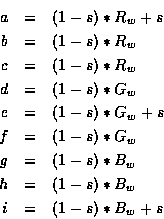



Next: 13.2.4.5 Hue Rotation
Up: 13.2.4 The Color Matrix
Previous: 13.2.4.3 Conversion to Luminance
The saturation of a color is the distance of that color from a
gray of equal intensity.[27] Haeberli has suggested
modifying saturation using the equation:
where:
with Rw, Gw, and Bw as described in the above section. Since
the saturation of a color is the difference between the color and a
gray value of equal intensity, it is comforting to note that setting
s to 0 gives the luminance equation. Setting s to 1 leaves
the saturation unchanged; setting it to -1 takes the complement of
the colors [39].
David Blythe
1999-08-06
![\begin{displaymath}\left[
\begin{array}{cccc}
R' \\
G' \\
B' \\
A
\end{array}...
...\left[
\begin{array}{c}
R \\
G \\
B \\
A
\end{array}\right]
\end{displaymath}](img210.gif)
![\begin{displaymath}\left[
\begin{array}{cccc}
R' \\
G' \\
B' \\
A
\end{array}...
...\left[
\begin{array}{c}
R \\
G \\
B \\
A
\end{array}\right]
\end{displaymath}](img210.gif)
